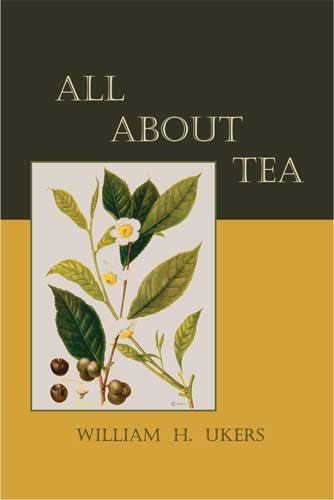
All about Coffee (Paperback)
This classic volume covers every aspect of coffee,–its history, production, and enjoyment. An illustrated encyclopaedic Bible of coffee.

This classic volume covers every aspect of coffee,–its history, production, and enjoyment. An illustrated encyclopaedic Bible of coffee.

Do you consider yourself a coffee lover? Perhaps you enjoy a good cup of coffee once a day…or maybe it’s a whole pot? But have you ever stopped and wondered just how much more you could enjoy coffee if you just knew a little bit more about it? For example, did you know that there are more than a handful of different ways to brew your morning “cuppa Joe”? “Everything You Ever Wanted to Know about Coffee” is designed to teach you more about coffee than you ever imagined you wanted to know. Don’t worry, we’re not about to take you through the anatomy of the coffee bean (is there such a thing?) but we are about to open your eyes to a whole new world of coffee flavor! From the differences between the different types of coffee plants, to the differences between roasting, grinding and brewing methods, this book will make sure that you are equipped to make the best cup of coffee of your life by the time you put it down!

REPRINT. Special Description Note- This is not a print on demand edition. Care has been taken to enhance and improve the original text whenever possible. Martino Publishing follows the standards of traditional printing and quality is a primary concern. We distinguish ourselves from Print on Demand by our quality controls, paper quality and binding quality. Hardbound. Octavo. Two volumes bound in one. fronts. (1 col.) illus. (incl. music) diagrs. 1143 pages. New York, The Tea and coffee trade journal company, 1935.In this book Ukers claimed to have assembled, in their right order, all the essential facts about tea. This flyleaf declaration is no idle boast. In two volumes of 54 chapters and 1143 pages, is an authoritative compendium of information on historical, technical, scientific, commercial, social, and artistic aspects of tea. The origin of tea is lost in mists of antiquity; legend ascribes it to the reign of Shen Nung, a mythical Chinese emperor of the third millennium B.C. The first credible mention is placed at 350A.D. From there the story is carried through the introduction of tea into Japan, Europe, England, and America; through the romantic age of trade on the clipper ships-“Oriental,” “Stag Hound,” “Flying Cloud,” “Lightning,” “Westward Ho,” “Taeping,” “Ariel”; and through the spread of tea culture into Java, Sumatra, India, Ceylon, and other lands. A description of the world’s leading growths of tea, with their market names and generalcharacteristics, is followed by a technical account of cultivation and manufacture in each of the principal producing countries, and an illuminating resume of the evolution of tea machinery. Under “scientific aspects” are chapters on the etymology,botany and histology, chemistry, pharmacology, and healthfulness of tea. The largest portion of the work, as might be expected, deals with commercial history and practice, which are set forth in panoramic, rather than dynamic, fashion. “Social Aspects” treat of tea as the “handmaiden of fashion and refinement,” of present-day tea manners and customs and their relation to the art of leisure; of appliances and the art of tea-making; of ideas which enter into and grow from the inducements of advertisers. The final section deals with the celebration of tea in the fine arts. An appendix contains a tea chronology, a tea dictionary, and an exhaustive bibliography of 23 pages in fine print. A classic and still essential work. Lavishly illustrated.

Everything but the Coffee casts a fresh eye on the world’s most famous coffee company, looking beyond baristas, movie cameos, and Paul McCartney CDs to understand what Starbucks can tell us about America. Bryant Simon visited hundreds of Starbucks around the world to ask, Why did Starbucks take hold so quickly with consumers? What did it seem to provide over and above a decent cup of coffee? Why at the moment of Starbucks’ profit-generating peak did the company lose its way, leaving observers baffled about how it might regain its customers and its cultural significance? Everything but the Coffee probes the company’s psychological, emotional, political, and sociological power to discover how Starbucks’ explosive success and rapid deflation exemplify American culture at this historical moment. Most importantly, it shows that Starbucks speaks to a deeply felt American need for predictability and class standing, community and authenticity, revealing that Starbucks’ appeal lies not in the product it sells but in the easily consumed identity it offers.

For coffee lovers and those who love them, Coffee Gives Me Superpowers is a fun, graphic design-centered book focused on one of the world’s most addictive and beloved substances–coffee.If coffee is the foundation of your food pyramid, then this is your book. Inspired by Ryoko Iwata’s popular Web site, I Love Coffee (en.ilovecoffee.jp), Coffee Gives Me Superpowers is overflowing with infographics and fun, interesting facts about the most awesome beverage on earth written by Ryoko, a Japanese coffee-lover living in Seattle. The book includes the most popular pieces on the site, such as “Your Brain on Beer vs. Coffee,” “10 Coffee Myths,” “The 15 Most Caffeinated Cities in the U.S.,” “The Best Time of Day to Drink Coffee (According to Science),” and “10 Things You Probably Didn’t Know about Caffeine,” plus 25 percent new, original material that is available only in this book.